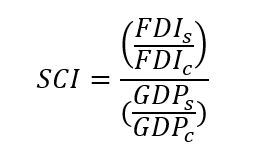
When considering India’s reputation as a foreign direct investment (FDI) hub, the states of Karnataka (home to Bengaluru) and Maharashtra (which contains Mumbai and Pune) typically come to mind, due to their robust infrastructure and well-established industrial ecosystems. However, it is Chandigarh, a lesser-known union territory with a population of just over one million, that ranks as India’s most competitive state for attracting inward FDI.
Its score of 2.79 places it just ahead of Telangana (2.58). Chandigarh’s score means that it is attracting 2.79 times its fair share of national greenfield FDI projects given the size of its economy. Despite accounting for just 0.17% of India’s gross domestic product (GDP), it manages to attract 0.48% of the country’s inward greenfield FDI.

Discover B2B Marketing That Performs
Combine business intelligence and editorial excellence to reach engaged professionals across 36 leading media platforms.
The union territory, boasting one of the highest per capita incomes in India, attracted six greenfield FDI projects in 2022. The US was the key source market in four out of six projects, while the remaining two projects originated from Canada and Austria.
Among these projects, US-based technology consulting company XenonStack announced plans to expand its workforce at its global delivery centre, generating 300 new jobs, while another US company, CBRE, opened a new office that will create 100 new jobs over the next two years.
Telangana punches above its weight
Telangana accounts for 5.01% of India’s GDP but receives 12.89% of the country’s inward greenfield FDI. The youngest state in India attracted 160 greenfield FDI projects in 2022. In fact, the majority of inward FDI in Telangana (91.8%) is destined for its capital city Hyderabad. Telangana’s largest city and technology hub was home to 147 unique international company expansions in 2022. It ranks as the 11th-largest FDI recipient city globally by number of greenfield projects, and fourth within Asia-Pacific.
US tech giant Microsoft announced plans to open three new data centres in Hyderabad in recent years, with an investment of $1.9bn. Meanwhile, in 2022, Biliti Electric, a US-based automotive manufacturer, announced plans to invest $150m to open the world‘s largest electric three-wheeler plant in Hyderabad, creating 3,000 jobs.

US Tariffs are shifting - will you react or anticipate?
Don’t let policy changes catch you off guard. Stay proactive with real-time data and expert analysis.
By GlobalDataMore than one-quarter of Indian states ‘in profit’ on FDI
In addition to Chandigarh and Telangana, six Indian states manage to score more than one in the index. Karnataka, the sixth-largest Indian state by area, and home to capital city Bangalore, ranks as the third most competitive state for attracting inward FDI with an index score of 2.11. The majority of inward investment within Karnataka is concentrated in its capital city of Bangalore. The city attracted 219 inward FDI projects in 2022, ranking sixth globally and second within Asia-Pacific, behind only Singapore.
Maharashtra received the highest number of FDI projects in India in 2022, although it only ranks fifth in the index with a score of 1.71. Despite accounting for 20.23% of India's inward investment projects, Maharashtra's contribution to national gross GDP stands at 11.82%. Furthermore, four other Indian states achieved index scores above one, indicating they are bigger contributors towards national inward investment than they are to national GDP. Among these states is Goa, the smallest state in India in terms of area. Despite attracting a significantly lower level of FDI when compared with Karnataka and Maharashtra, Goa ranks fourth in the index with a score of 1.71, mainly due to its lower contribution to India’s GDP (0.33%). Other states scoring above one in the index include Haryana (1.44), Tamil Nadu (1.44) and Delhi (1.08).
Who wins for FDI in India over the longer term?
There is little variation in the proportion of national GDP accounted for by each Indian state between 2019 and 2022. However, there are notable changes in volumes of inward investment projects by state, by year. Telangana and Karnataka are the only states to have an inward investment state competitiveness index score above two in each of the past four years. Chandigarh scores above two in three of the past four years.
Some states are more volatile. Goa has experienced a state competitiveness score above and below one across the period while Odisha, Kerala, Uttarakhand and Himachal Pradesh have also been volatile; however, in each year their scores have been below one.
Other states including West Bengal, Uttar Pradesh, Rajasthan and Punjab consistently maintained scores below one. However, their annual fluctuations were comparatively less volatile.
Methodology
A state competitiveness index (SCI) score is calculated for each state and union territory. The calculation is based on the number of inward greenfield FDI projects a state receives as a share of the country total. This value is then divided by the state’s proportion of economic output (GDP). A score above one indicates that the state is receiving more FDI than would be expected given the size of its economy (it is overperforming). To the contrary, a score less than one indicates a state is underperforming in terms of the amount of inward investment it receives given the size of its economic output.

The SCI is where FDI is the number of inbound greenfield FDI projects; GDP is gross domestic product; s is the state; and c is the country.



